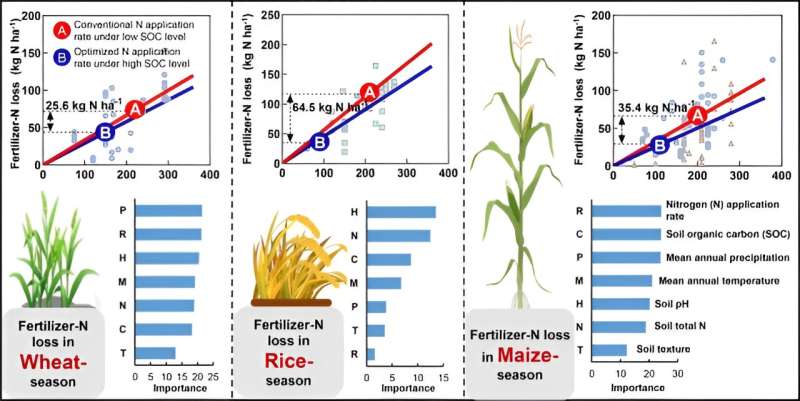This article has been reviewed according to Science X's editorial process and policies. Editors have highlighted the following attributes while ensuring the content's credibility:
fact-checked
proofread
Study finds patterns of crop-specific fertilizer-nitrogen losses, opportunities for sustainable mitigation

Nitrogen fertilizers play an essential role in ensuring global food security. However, the applied fertilizer-nitrogen, particularly that exceeding crop demand and soil N retention capacity, can potentially escape into the environment and lead to a variety of negative environmental impacts.
Understanding crop-specific fertilizer-nitrogen loss patterns, driving factors, and mitigation potentials is vital for developing specific mitigation strategies. This study highlights the significance of soil organic carbon in minimizing N losses from fertilizer-nitrogen and estimates that 35%−60% of these losses could be potentially reduced through optimized management of soil nitrogen and carbon.
The researchers' study was published in Soil Ecology Letters.
Fertilizer-nitrogen losses can be influenced by various factors, such as fertilizer-nitrogen application rates, natural factors, and soil parameters. However, quantitatively determining the effects of these factors and finding solutions to mitigate gross fertilizer-nitrogen losses remains a challenge.
On one hand, the significant spatial heterogeneity of natural factors and management practices across different regions makes it difficult to draw up mitigation guidelines at regional or broader scales. On the other hand, there is a lack of reports that account for the variation in fertilizer-nitrogen losses in soils cultivated with different crops, which hinders our understanding of crop-specific characteristics of fertilizer-nitrogen losses.
The study conducted a global meta-analysis, i.e., a quantitative synthesis study approach, to facilitate an analysis of spatial patterns. The study specifically focused on 15N isotope tracing publications, as this approach enables the direct measurement of gross fertilizer-nitrogen losses.
Based on the analysis of 940 observations from 79 published research studies, it was found that China had the highest conventional fertilizer-nitrogen application and loss rates, as well as the lowest soil organic carbon contents among the countries/regions examined. Therefore, optimizing fertilizer-nitrogen application rates is crucial for mitigating its losses. Furthermore, regression analysis and random forest models confirmed the critical role of soil organic carbon in retaining soil nitrogen.
The researchers also conducted a scenario analysis to assess the potential for reducing fertilizer-nitrogen loss through optimized nitrogen and carbon management. The results revealed that by adopting optimized management practices, it was possible to mitigate between 35% and 60% of fertilizer-nitrogen losses without affecting crop yields. Additionally, this approach could neutralize greenhouse gas emissions equivalent to 55.0–135 tons of carbon dioxide per hectare.
This study provides a comprehensive analysis of the factors that contribute to the loss of fertilizer-nitrogen and their potential for mitigation at a global level. The findings of this study will enable a more precise evaluation of the environmental risks associated with nitrogen fertilization and aid in the development of crop-specific carbon and nitrogen management strategies.
More information: Cong Xu et al, Patterns of crop-specific fertilizer-nitrogen losses and opportunities for sustainable mitigation: A quantitative overview of 15N-tracing studies, Soil Ecology Letters (2023). DOI: 10.1007/s42832-023-0206-2
Provided by Frontiers Journals



















